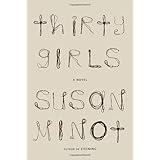 I hadn't planned to write about this novel, which I read over a month ago, because I found it uneven and ultimately unsatisfying. However, I've been obsessing about the young Nigerian girls who were kidnapped from their school in April, and Nicholas Kristof's editorial in the paper this morning http://nyti.ms/Snusou prodded me to speak out.
I hadn't planned to write about this novel, which I read over a month ago, because I found it uneven and ultimately unsatisfying. However, I've been obsessing about the young Nigerian girls who were kidnapped from their school in April, and Nicholas Kristof's editorial in the paper this morning http://nyti.ms/Snusou prodded me to speak out.This may sound crazy, but I'd almost think that members of the Nigerian terrorist group, Boko Haram, had read Ms. Minot's book and followed its plot to a tee. The only difference is that "Thirty Girls" is set in Uganda and the terrorists are a different, but equally feared Muslim extremist group, called The Lord's Resistance Army. In Ms. Minot's novel, the LRA storm a convent school, long after the girls, ranging in age from 10 to 18, have been locked in for the night by the nuns.
The armed men batter down the doors, set fires, and tie the girls together with rope, marching them off into the jungle before the elderly teachers can comprehend what has happened. In an act of remarkable selflessness, Sister Giulia and another teacher, set off to negotiate with Joseph Kony, the infamous leader of the Lord's Resistance, for the return of her 139 girls. He releases all but thirty. One of the girls he keeps for himself is Esther.
This novel is written in two parts. Esther's story as a captive with the LRA is heart-stopping and immediate. As you read, you can't help but realize that these atrocities are happening right now, as I write, in northern Nigeria.
The opposing section of the book revolves around an American journalist, Jane Wood, a young widow at loose ends, who travels to Uganda hoping to meet with and interview a few of the girls who have been held in captivity. Jane meets up with a cadre of ex-pats living in Nairobi who supposedly just decide to tag along with her into Uganda, protesting all the way about the state of the roads, the lodgings, and the dangers of the trip.
Their odyssey becomes an annoying distraction from Esther, who is at the heart of the novel, even as it serves to point up the ridiculous expectations of the over-privileged Westerners who travel in Africa without any sense of reality.
Minot is at her best when her imagination delves into the hearts and minds of these devastated girls whose only sin is trying to obtain an education in a country where women's brains have no value. They, like Ishmael Beah's boy soldiers, described in his powerful book, "Long Way Gone," have been forced to commit horrific deeds. They have been raped, dehumanized, they have killed and mutilated. Can they ever recover their humanity?
I can't help but wonder how we can launch drones over the skies in Afghanistan that can pinpoint and take out a single target with frightening agility, yet we cannot put drone technology to work to locate these young women who are held captive in the jungles of their own countries. Desperate parents want to know why no one is helping to "bring back our girls."

No comments:
Post a Comment